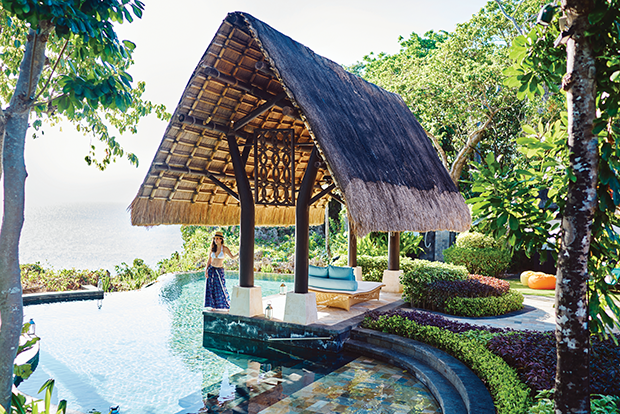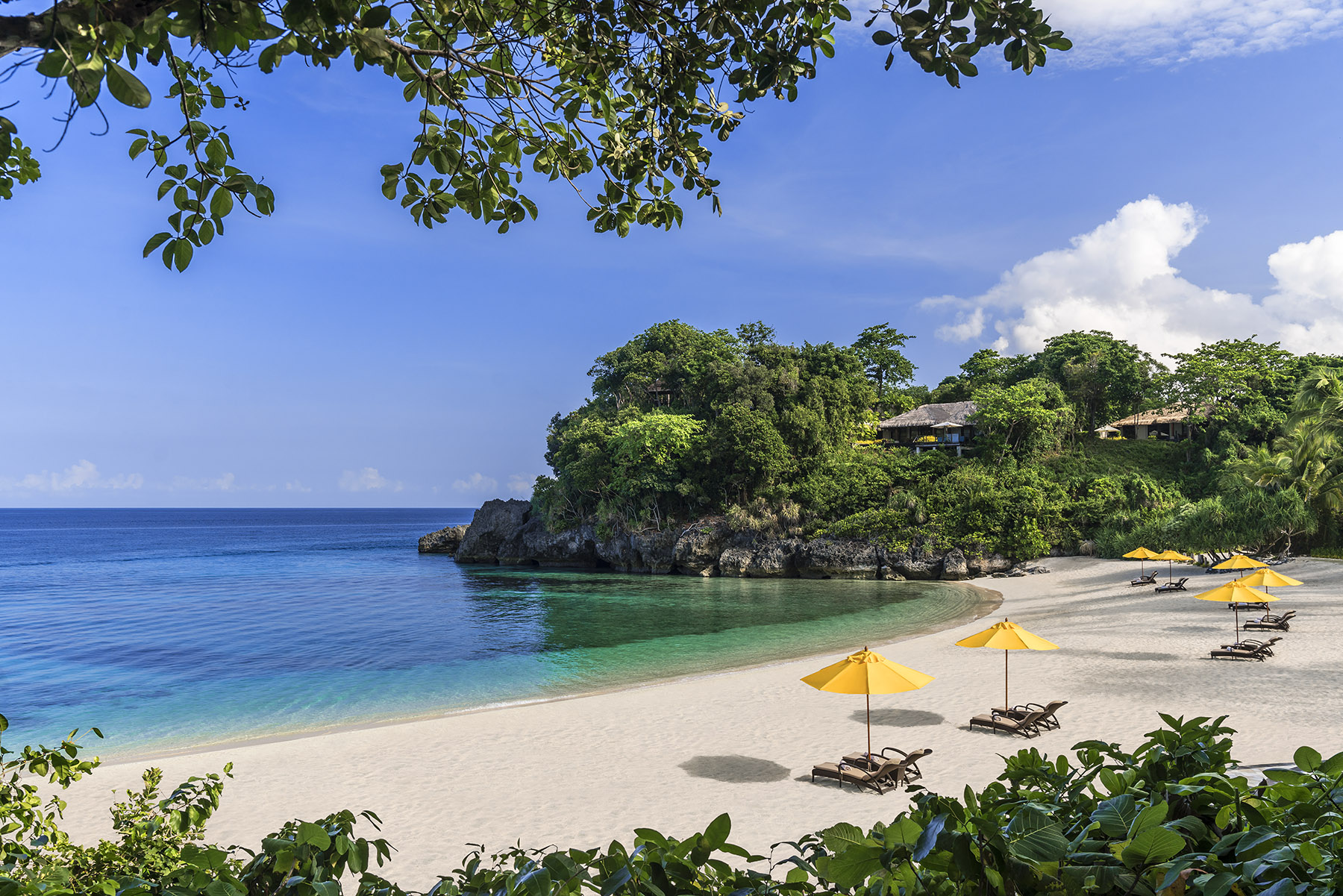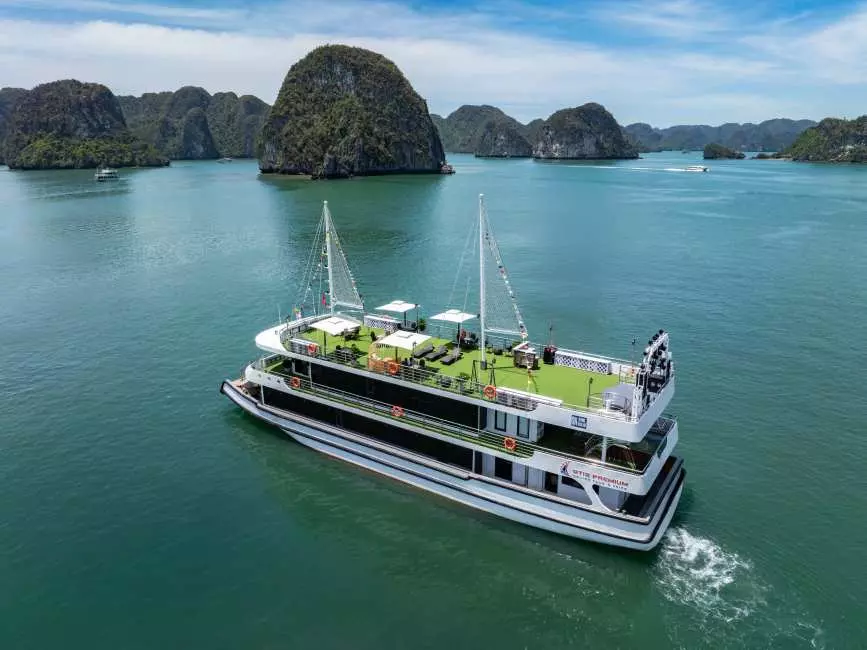I CONFESS I WAS a little anxious as I sat there on the plane. It was going to be the first time I’d see Boracay again after a long period. I loved it once, had been infatuated by the magic and seemingly endless possibilities. My memory bank is highlighted by long twilit walks with my first love on the beach, inebriated sunrises that pushed my sensory boundaries, raucous and joyful dinners with my entire family followed by hours of dancing on the shore to ring in countless new years. To me, Boracay has always been a place where you could be whatever you wanted to be.
Flourlike white beaches famed throughout Asia, crystalline turquoise waters, that laidback island lifestyle set against her iconic golden sunset… Boracay was known not just for its party scene but also offering a true connection to the island. Its life as a holiday destination began in the late ’70s when it appeared in the film Too Late The Hero, and in a quick decade it became a popular stop for backpackers and adventure travelers. By the 1990s, it was fully on the tourist map—yet, even then, people walked on the sand, danced barefoot under the moonlight, lived close to the shore.
64r021h%20-%20Loft%20Villa.jpg)
Loft Villa in Shangri-La Boracay’s Resort and Spa.
It was paradise. Until it was not. Time took its toll. Bad choices and a rough period—the easy geniality having hardened by fast business and a loose lifestyle. My once-deep love dwindling, I began only returning gingerly and was always left with a bit of disappointment afterwards.
Eventually things really went off the rails. Rapid, unrestricted development, mass uncontrolled tourism—the infamous May 1 anything-goes trashy-party “Laboracay” tradition became symbolic rather than an anomaly. Insane commercialization left little of the Boracay I once knew. What did paradise have left to offer when its sands were littered with cigarette butts and broken beer bottles, the easy-breezy visitor demographic taken over by bucket-list tour groups in matching baseball caps, and the deceivingly clear waters tainted with E-coli? It’s a question many beloved places are needing to ask themselves these days, as overdevelopment and overtourism have marred many of the region’s most beautiful destinations, from Angkor to parts of Bali.
Hard choices have to be made, a delicate balance of what’s best for a country’s economy and its—the world’s, really—environment. In Thailand, for example, Maya Bay on Koh Phi Phi, made famous by the Leonardo di Caprio movie The Beach and visited by a shocking 4,000 people a day trampling its coral, has had its closure extended to 2021 “until natural resources return to normal.” Bad for Instagram, good for everything else.
This came in the wake of the Philippines’ decision to shut Boracay to tourism in April 2019, for six months, but with no real guarantee that it would reopen. An estimated 1.7 million visitors a year proved far too many for a 10-square-kilometer idyll. “As long as there is shit coming out of those pipes, I will never give you the time of day to return to the island,” President Rodrigo Duterte proclaimed in reference to the 716 out 834 businesses and residences that were said to be dumping their sewage into the waters. And so, Boracay was sent to rehab.
Now I was heading back, ostensibly to evaluate how an iconic tourist destination could reinvent itself cleaner and greener. But, on a more personal level, to see if I could fall in love all over again with the island of my youth.

The Shallows in front of Crimson Resort and Spa.
“I WAS DEVASTATED, and afraid of the future,” says Djila Winebrenner, owner of The Lazy Dog and 15-year resident of Boracay. “All we knew was that there was going to be no income.” Sitting in the café of her Bulabog-side B&B, a Boracay institution, Djila expresses what everyone on the island was feeling last year: insecurity. Some businesses were more prepared to weather the tourism drought, while others have been forced to shutter themselves permanently.
The way the shutdown was originally positioned made many longtime residents and business owners uncomfortable. “The government, the media, the netizens—they all called us greedy, they said we were breaking the law. That hurt a lot of people, because for years we were clamoring for attention from the government to address overdevelopment issues and we never got it,” Djila says. In the end, personal feelings aside, she sees net benefit to the closure. “I’m glad it happened, because it may not have happened at all.”
Cold turkey seemed to be the only way and, coming out of rehabilitation, Boracay is looking well. You can see that whatever trauma it has been through, the necessary treatments and therapies are being administered. Roads have been widened and paved. Most of the piping has been laid for proper sewage. Electrical wires have been cleaned up.
To help the island stay on the eco-friendly track, citizens’ arrests have been authorized for litterbugs. The local government has mandated a shift to electric and solar-powered tricycles and is slowly phasing out the old passenger trikes to combat climate change, and air and noise pollution. Other measures include limiting the island’s capacity to 19,000 a day, with all visitors needing a confirmed booking from accredited hotels; watersports such as Jetskiing need to be 200 meters away from the shoreline; and no more daybeds, tables and chairs in the 30-meter-from-shore exclusion zone. Most significant is the ban on alcohol and smoking on the beaches, with Tourism Police strictly enforcing this and imposing fines.
It’s still a work in progress, particularly in the back end where construction isn’t quite done yet. Famous White Beach, however, has returned to spectacular.

Banyugan beach
Originally a string of small resorts, cute bars, restaurants and shops, White Beach is the Boracay my father is always nostalgic for. But that’s long gone—having been replaced in later years by mass tourism tropes, cheesy banana boats out at sea. Now, cleaned of trash and debris, stripped of all the lounge chairs and tables that had encroached on her precious shores, White Beach is completely refreshed and returning to how I remember it. The architecture is no longer rustic, the vibe is not so much barefoot, but that sparkle is back. The clear waters are truly clear; tests have shown that it is now safe. The best proof of this: marine life has already returned and the massive carpets of icky green algae have been reduced to a few healthy natural tufts.
For those who know Boracay, the mood has changed. It feels more corporate, more constructed but also more peaceful and calm since they’ve been strictly enforcing curfews and noise pollution regulations. “It’s no longer ‘Party Island.’ I’m glad all the crazy parties are gone,” Djila says, but adds wistfully, “so are the good quality parties from the local community that has been here all these years and helped create that vibe.” I wonder out loud… with all these changes, what’s the draw for the long- time visitor—or even for a new one on the hunt for castaway island magic?
Just then, a shaft of light falls through the trees, directly onto Djila. Her eyes twinkle and her big warm smile returns. “It’s a bit harder to find these days,” she says, “but it’s still magical.”
BORACAY IS FAMOUS for its sunsets, and it reminds me why while I am precariously perched on the ledge of Sirena, the cocktail bar of Shangri-La Boracay’s Resort and Spa. The sky turns a spectacular shade of orange, the golden orb kisses the sea and the shore, setting them ablaze. I feel as captivated as I ever have been.
64f008h%20-%20Solana.jpg)
Solena in Shangri-La
Over the years, when things at White Beach had gotten too crazy, I called Shangri-La, in the northern part of the island, home. I’ve stayed in all room and villa types, and on this trip I am quite serendipitously in the same Treetop villa that I stayed in on my first check-in. I sleep with the curtains open so I wake with first light to the Rothkoesque, unobstructed view of ocean and sky. I requested a yoga mat, and my first morning’s practice on the terrace, under chirping birds, is one of the most amazing moments of my year to date. Balancing on my headstand, I face the verdant canopy of trees the resort has preserved, and appreciate all the efforts—protecting the island’s endangered fruit-eating bats and on-going coral rehab, for example—they’ve made to stay sustainable and close to nature.
Shangri-La Boracay celebrates its tenth anniversary in 2019 and is better than ever. One of the few resorts on the island that has an excellent support system, this grand dame took advantage of the closure for refurbishments and repairs. No staff were let go, with many sent off for training at other Shangri-Las, a win-win. The service is impeccable, personal and warm. I come back to my villa one afternoon to a canvas set up on an easel with paints and brushes on a table next to a bottle of wine. A note from my villa manager, Suzette, encourages me to enjoy the sunset.
With its own cove, incredible spa, amazing wine list and F&B selection, it’s easy to never leave the property. But, as a private enclave, it’s not quite Boracay—and I need to get out to see how things have changed. Shangri-La while still peaceful is no longer solitary; its home on “Station Zero” has seen the opening of a few resorts, such as Crimson. A short walk down the beach brings you to this ultra-modern, Mediterranean white structure. Proud perpetrators of the longest happy hour on the island (10 a.m. to midnight), Crimson has fantastic food to accompany all that boozing. Think tandoori chicken with buttered naan or fresh tuna tataki. The Latin American fine-dining outlet, Mosaic, is definitely worth a visit, offering excellent grilled steaks and Peruvian tiraditos. The smoked prawn ceviche is plated beautifully and engulfed in a wispy cloud of smoke, the fresh raw prawns curing slowly in the symphony of tangy and spicy sauces that vibe with the sun streaming through the patterned window frames, Latin classic Besa Me Mucho on the stereo, and my refreshing Campari soda.
Azure Beach Club at Crimson
Full disclosure: I actually had been to Boracay once before right after it reopened—but our stay was so brief we only had time for one proper meal at The Lind, a contemporary, airy resort where friends were getting married. The wedding had been planned for early November 2018 and the bride and groom were crossing their fingers and toes that the island would be back in time. Happily, the miraculous happened and the government was true to its word, opening the island on October 26.
I was impressed with how well-oiled everything was at The Lind, considering its six-month hiatus. Our server at that time, Darwin, who is now the F&B supervisor, made sure our rosé was always delivered frosty to our balcony for sunset sessions. And I encountered one of the best dishes I’d ever eaten on the island, which left me dreaming about it for months: grilled octopus, tender yet charred, crisping the delicate tips of the tentacles, bits of smoky chorizo mingling with roasted tomatoes and the best darn romesco sauce in recent memory. I would have returned just for that meal, but the property is pretty amazing all round, with wonderful views, family-friendly facilities and a really worthy piece of real estate: daybeds on the sands.

Common lounge at The Lazy Dog
Unlike most of their neighbors, The Lind allotted enough space for a lounge area—meaning, importantly, they adhered to proper setbacks on the beach. Sustainability has always been at the core of both The Lind and Shangri-La; their long-term efforts to reduce single-use plastics have been joined by many other establishments since the imposition of new, strict, reopening regulations.
And while The Lind’s marketing and communications manager Quino de Jesus isn’t wrong when he says, “All the resorts look pretty much the same now,” in reference to the crop of white, cement, modern buildings that have replaced the little rustic huts of yore, another change is an increased emphasis on design. The old Filipino cliché, “What happens in Boracay, stays in Boracay,” is out the window now that everything is all about Instagram. The younger generation’s preoccupation with social media likes over actually socializing means the island is not saved from the growing need for F&B to be photogenic. But to prove that’s not all bad, visit Station X, a hip resort complex that lacks in beachfront what it makes up for in cute, quirky décor and fantastic retail concepts. The food market has a curry crab to die for, great oysters, poke bowls and Korean bingsu. Round it off with some craft coffee and cocktails. I love shopping for souvenirs at Local Color, which has thoughtfully curated, well designed products from local artists and artisans. While a very different groove from the original Boracay I loved, it’s full of fresh, dynamic energy.

All day dining in Tartine at the Lind
A LOT OF THINGS have changed for the better and yet there is still uncertainty in the air. Back at Bulabog beach, Djila and I walk past a whole row of boutique kitesurfing resorts that have been boarded up for the controversial reason of “easement”—the requirement that properties be 30 meters from the waterline.
We meet Ken Nacor, a local who was Asia’s No. 1 kitesurfing freestyle champion for several years. After exchanging hellos, Djila explains to me that Ken is losing his livelihood and everything he’s saved up for, with zero compensation. I look back and see him sitting in front of his establishment—one of several titled properties losing their real estate to make way for an extension of a boulevard—eerily boarded up, staring out to that paradoxically beautiful sea, hovering like a spirit in limbo over the shell of a body.
It leaves me sad and full of unanswered questions. As much I agree with the need to cure Boracay, measures should be implemented fairly and with a proper action plan to address the collateral damage. Taking titled land away from owners without recompense and without making public the intentions doesn’t sit right. It’s apiece with the new trike-taxi regulations: many locals own their individual tricycles and now, though at the lower end of the economic chain, are being told to reinvest in green-powered vehicles without assistance. It feels a bit unfair when other fossil-fuel vehicles such as cars and trucks are still allowed on the island.
There’s no disputing that the main attraction, that sand so white and fine it’s unreal, is finally back to its old pure state and so are the clear, turquoise waters. I just hope the improvements are not a Trojan horse. Rumor had it that the closure was in fact preparation for the opening of a large casino, after a provisional license was granted to Macau-based Galaxy Entertainment Group by the Philippine Amusement and Gaming Corporation the month before Boracay’s closure. President Duterte, however, has been adamant about his stance against gambling on the island, pledging that no such casino would come to fruition under his term. Even if that’s true, what happens after?

Entrance interior at The Lazy Dog
My last evening is spent on the iconic White Beach. The paraws—sailboats that are finally, thankfully devoid of advertising—dance a graceful ballet across the painterly sky. The tide is pulled back so far that the shore is like a looking glass, creating prisms of scarlet and gold. The sunset is glorious. No raucous music; instead the beach filled with good, happy energy, kids boogie-boarding, couples taking photos, a friendly pug splashing about.
The day eases seamlessly into night and I head to a party to meet some friends. In Boracay, there are always friends around. I had geared myself up for a crazy, drunken night. Friday in the middle of summer—why wouldn’t it be? But the island is calm. Our party tapers off early and, out of curiosity, I want to see if there’s perhaps anywhere else to carry on. I walk out on the beach, where instead of the usual boom boom there is a serene hush. Children are playing with light-up toys, glittering like neon falling stars on a dark sky. I take in the balmy sea air and heave a sigh. I don’t miss the blow-out, I no longer need it here. I’m happy with the chill cocktails and meaningful conversations. I’m happy with the morning yoga and mind-blowing massages. I don’t need much more than just to be at peace by the sea. Like me, the island has matured. It has transitioned from a wild, unbridled paradise to something more measured and relaxed. The immediate vibe for a visitor might be less carefree, but it feels a worthy trade for protecting the future.
– STEPHANIE ZUBIR
THE DETAILS
STAY
Crimson Resorts and Spa Boracay
Perfect for travellers looking for a party. crimsonhotel.com; doubles from P14,000.
The Lazy Dog
Cute value spot on the kitesurfing side. lazydogboracay.com; doubles from US$15.
The Lind
A modern favorite on White Beach with daybeds on the sands. thelindhotels.com; doubles from US$320.
Shangri-La Boracay’s Resort and Spa
Rustic luxury, butler service and private beaches. shangri-la.com; doubles from P19,000.
EAT+DRINK
Exit Bar
A simple hut with a great local vibe and eclectic music; go for last call. Station 2; drinks for two P500.
Lanterna Home Kitchen
Authentic Italian private dining by chef Luigi Barbolla. +63 998 575 2540; P850 per person.
Station X / Prisma
Young, hip and photogenic, global eats, good cocktails. thehuehotel.com; meal for two P1,500.

